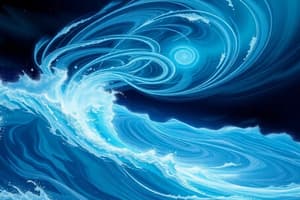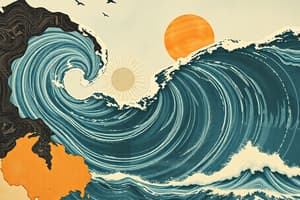Podcast
Questions and Answers
Travellers to the continent situated to the east of the International Date Line will gain one day on crossing the line.
Travellers to the continent situated to the east of the International Date Line will gain one day on crossing the line.
True (A)
The time in India is 5 hours and 30 minutes behind Greenwich Mean Time.
The time in India is 5 hours and 30 minutes behind Greenwich Mean Time.
False (B)
Japan is situated to the west of India.
Japan is situated to the west of India.
False (B)
The time difference for 1° longitude is 4 hours.
The time difference for 1° longitude is 4 hours.
When it is 12 noon at Greenwich, the time in India will be 5.30 pm.
When it is 12 noon at Greenwich, the time in India will be 5.30 pm.
Japan is situated 52°30' west of India.
Japan is situated 52°30' west of India.
The surveys conducted by the East India Company in the Indian subcontinent were initiated by Col. William Lambton.
The surveys conducted by the East India Company in the Indian subcontinent were initiated by Col. William Lambton.
The surveys undertaken by the East India Company were completed in less than 50 years.
The surveys undertaken by the East India Company were completed in less than 50 years.
George Everest joined Col. Lambton's team before 1818.
George Everest joined Col. Lambton's team before 1818.
The heavy metallic survey instrument used during the surveys was called a telescope.
The heavy metallic survey instrument used during the surveys was called a telescope.
Mount Everest was named after Col. George Everest.
Mount Everest was named after Col. George Everest.
The first topographic maps of the Indian subcontinent were prepared in 1854.
The first topographic maps of the Indian subcontinent were prepared in 1854.
Due to Coriolis effect, the pattern of winds in anticyclones is clockwise in the Northern Hemisphere and counterclockwise in the Southern Hemisphere.
Due to Coriolis effect, the pattern of winds in anticyclones is clockwise in the Northern Hemisphere and counterclockwise in the Southern Hemisphere.
Temperature, altitude, and humidity are directly proportional to atmospheric pressure.
Temperature, altitude, and humidity are directly proportional to atmospheric pressure.
The driving force behind the continuous movement of air is the Moon.
The driving force behind the continuous movement of air is the Moon.
The Coriolis effect causes winds to move in straight paths without any deflection.
The Coriolis effect causes winds to move in straight paths without any deflection.
Monsoon winds are considered local winds.
Monsoon winds are considered local winds.
The Sun's energy plays no role in the movement of air and wind patterns on Earth.
The Sun's energy plays no role in the movement of air and wind patterns on Earth.
Sea breeze is caused by low pressure over the land.
Sea breeze is caused by low pressure over the land.
During the night, land breeze is formed due to high pressure over the sea.
During the night, land breeze is formed due to high pressure over the sea.
Valley breeze occurs when air flows downslope from the mountains during the day.
Valley breeze occurs when air flows downslope from the mountains during the day.
Mountain breeze happens at night when cool air moves towards the valley.
Mountain breeze happens at night when cool air moves towards the valley.
Local winds are caused by global pressure differences and are very strong.
Local winds are caused by global pressure differences and are very strong.
Chinook, Harmattan, and Foehn are examples of local winds experienced in India.
Chinook, Harmattan, and Foehn are examples of local winds experienced in India.
The topographic maps prepared in India are known as 'Survey of India Maps' (SOI maps).
The topographic maps prepared in India are known as 'Survey of India Maps' (SOI maps).
There are 2222 sheets picturing the whole world in the Survey of India topographic maps.
There are 2222 sheets picturing the whole world in the Survey of India topographic maps.
Each map in the India and Adjoining Countries Map Series is in a scale of 1:1000000, known as million sheets.
Each map in the India and Adjoining Countries Map Series is in a scale of 1:1000000, known as million sheets.
The index numbers given to the million sheets cover a 4° latitudinal and 4° longitudinal extent.
The index numbers given to the million sheets cover a 4° latitudinal and 4° longitudinal extent.
Each million sheet is divided into 12 parts in alphabetical order from A to L.
Each million sheet is divided into 12 parts in alphabetical order from A to L.
The degree sheets in the million sheets are labeled from A to P.
The degree sheets in the million sheets are labeled from A to P.
Flashcards are hidden until you start studying
Study Notes
Time Zones and Longitude
- Travellers crossing the International Date Line from the west will lose one day
- India is 5 hours and 30 minutes behind Greenwich Mean Time
- Japan is situated west of India, and 52°30' west of India
- 1° longitude is equivalent to 4 hours time difference
- When it is 12 noon at Greenwich, the time in India is 6:30 pm
History of Surveys in Indian Subcontinent
- Surveys in the Indian subcontinent were initiated by Col. William Lambton
- George Everest joined Col. Lambton's team before 1818
- The heavy metallic survey instrument used was called a telescope
- Mount Everest was named after Col. George Everest
- The first topographic maps of the Indian subcontinent were prepared in 1854
Atmospheric Pressures and Winds
- The Coriolis effect causes winds to move in curved paths
- Winds in anticyclones move clockwise in the Northern Hemisphere and counterclockwise in the Southern Hemisphere
- Temperature, altitude, and humidity are directly proportional to atmospheric pressure
- The driving force behind air movement is not the Moon
- Sea breeze is caused by high pressure over the sea
- Land breeze forms at night due to low pressure over the land
- Valley breeze occurs when air flows downslope from mountains during the day
- Mountain breeze occurs at night when cool air moves towards the valley
Local Winds and Maps
- Monsoon winds are considered local winds
- Chinook, Harmattan, and Foehn are examples of local winds experienced in India
- The Survey of India topographic maps are known as 'Survey of India Maps' (SOI maps)
- There are 2222 sheets picturing the whole world in the Survey of India topographic maps
- Each map in the India and Adjoining Countries Map Series is in a scale of 1:1000000 (million sheets)
- Each million sheet is divided into 12 parts in alphabetical order from A to L
- The degree sheets in the million sheets are labeled from A to P
Studying That Suits You
Use AI to generate personalized quizzes and flashcards to suit your learning preferences.




